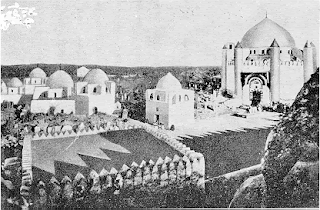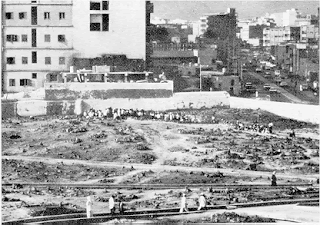Governor’s rule imposed in Balochistan
Dawn, Jan 14, 2013
http://dawn.com/2013/01/14/constitutions-article-234-invoked-to-defuse-tension-in-quetta-governors-rule-imposed-in-balochistan/
QUETTA: The PPP government finally yielded to the protests that had enveloped the entire country over the weekend and Prime Minister Raja Pervez Ashraf announced in front of a gathering of representatives of Hazara Shia community late on Sunday night that the provincial government was being dismissed forthwith and governor’s rule was being imposed in the whole of Balochistan.
“After holding consultations with all the stakeholders, we have decided to invoke Article 234 of the Constitution. Governor’s rule is being imposed in the province and the provincial government is being dismissed,” Mr Ashraf announced in front of the Hazara representatives.
His announcement was welcomed by thousands of Hazara Shias who had been staging a sit-in in freezing cold on Alamdar Road for the last three days along with the bodies of dozens of people killed in bombings on Thursday.
The prime minister took a bold but extremely necessary step of visiting the place in the middle of the night to make the announcement.
Earlier in the day, leaving Interior Minister Rehman Malik to deal with the Qadri march on Islamabad, Prime Minister Raja Pervez Ashraf rushed to Quetta as the government braced itself against countrywide protests.
As night fell the protests had gained so much momentum that when media reports came that the prime minister was considering dismissing the provincial government, they seemed believable.
Protesting the carnage caused by three blasts in the provincial capital on Thursday, Hazaras, along with the unburied bodies of the victims, took to the streets on Friday, saying that the sit-in would not end and the funerals would not take place till the government called in the military to put an end to the attacks.
By Saturday, parallel protests had begun in major cities such as Lahore, Karachi and Islamabad — organised by Shia groups and parties as well as civil society.
On Sunday, these protests seemed to have enveloped the entire country, reducing the long march, which had dominated the political scene for the past few weeks, to a side story.
From Lahore to Karachi to Islamabad to Multan in the south and Skardu in the snow-covered north, the protests drew in more and more people. From religious leaders to women and children, the Pakistanis were united in condemning the targeted killing of an ethnic community and a sect, whose deaths had dominated the stories of violence and mayhem coming out of Pakistan in 2012.
Slogans such as “End to the killings of Shias” reverberated in every city and placards that read “Am I the next victim” were pictured in the hands of men, women and small children.
In Islamabad, the civil society protest continued overnight.
The Shia groups and parties, which had dispersed late on Saturday night, re-appeared and blocked a major road connecting the twin cities. Another protest by the parties also blocked part of the Islamabad-Lahore motorway.
In the opposite end of Pakistan, one group of protesters headed for the heavily protected Bilawal House where President Asif Ali Zardari has been ensconced for weeks. Despite being threatened by water canons — a favoured SOP of the Karachi police — the protest continued.
Other protests in the city were at Malir, M.A. Jinnah Road, Ancholi in Federal ‘B’ Area and North Nazimabad. At most of the protests, women were present in large numbers.
These were not protests that were limited to a particular political party or a particular social class.
Lahore too witnessed protests.
The demonstrations and the anger behind them were so palpable that the political leadership was forced to react in an unprecedented manner. The barrage of criticism directed at the PPP at the centre and in Balochistan had sent the party leadership into feverish activity by Sunday morning.
The prime minister flew into Quetta and was holed up in the Governor’s House all day, accompanied by Information Minister Qamar Zaman Kaira.
There was no news on when he planned to return but there were multiple reports that the PPP was now going to do something it had refused to do earlier when the Supreme Court had observed in its order on the Balochistan security situation case that the
provincial government had lost its constitutional authority to rule.
The federal government had then refused to touch the provincial government but on Sunday it could no longer hold firm.
Prime Minister Raja Ashraf met provincial ministers, conferred with the governor and Law Minister Farooq Naek on the various options available which included, reportedly, the dismissal of the government and imposition of governor’s rule.
Phone calls went back and forth.
But despite all the activity, the Balochistan chief minister, who is probably the most criticised politician in the country at the moment, and a PPP member, did not return to Pakistan.
By the evening, even politicians were echoing the protesters’ demand to remove him. The MQM, ANP chief Asfandyar Wali and PML-Q leader Chaudhry Shujaat Hussain demanded that he be removed.
The political leadership was also forced into action by the growing protests.
Imran Khan, the Pakistan Tehrik-i-Insaaf chief, turned up at the Quetta protest early on Sunday morning, while the rest of the political leaders also headed for protest destinations in various cities later. Some PML-N leaders showed up at a protest in Lahore while the MQM joined the protesters in Karachi. Even the local Jamaat-i-Islami representative in Islamabad spoke at the civil society protest.
Others were forced to provide sound bites to the media in a bid to show they cared. General (retd) Pervez Musharraf also spoke to news channels on the issue.
All eyes are now on the Bilawal House in Karachi and the Governor’s House in Quetta — only they can now end this wave of anger that has swept the entire country.
— Additional reporting by our correspondents in Quetta, Karachi and Lahore





